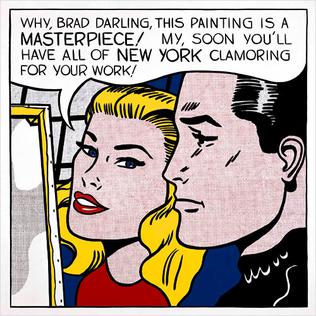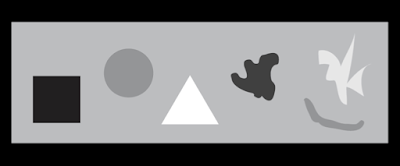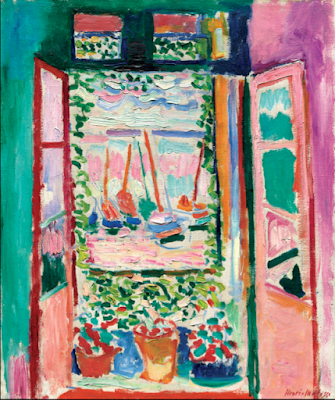Marcel Duchamp Fountain 1917
The most famous of Duchamp's Dadaist "readymade" sculptures, a store-bought mass-produced ceramic urinal turned upsidedown and signed with a fake name. Voted the most influential artwork of the 20th century.
Jeff Koons Rabbit 1986
Larry Poons - Turned His Head 2017 acrylic on canvas 64 x 144.5 inches
Poons was the crotchety motorcycle-riding painter examined in "The Price as Everything" as a contrast to Jeff Koons. He turned his back on the art market to pursue his own artistic vision. This piece combines elements of abstract expressionism and color field painting.
Damien Hirst The Physical Impossibility of Death in the Mind of Someone Living, 1991
85.5 x 213.4 x 70.9 in Glass, painted steel, silicone, monofilament, shark and formaldehyde
Post Modern Pop sculpture - appropriated from industrially produced educational/museum object.

Spider, ancient earthwork, Nazca Desert, Peru, approx 154 ft long


Jean Tinguely, Homage to New York : a self-contructing and self-destroying work of art
Joseph Beuys I Like America and America Likes Me 1974
Georgia O’Keeffe, Music—Pink and Blue II, 1919. Oil on canvas, 35 × 29⅛”
Tim Hawkinson Balloon Self-Portrait, 1993 Inflated latex 72 × 48 × 33 in

Rachel Whiteread, House, 1993, concrete

Louise Bourgeois, Maman, 1999 (cast 2001).

Méret Oppenheim, Object, 1936. Fur-covered cup, saucer, and spoon, 2⅞” high
Post Modern Pop sculpture - appropriated from industrially produced educational/museum object.

Spider, ancient earthwork, Nazca Desert, Peru, approx 154 ft long
The Nazca Lines in southern Peru are a group of pre-Columbian geoglyphs etched into desert sands between 500 BC and 500 AD. Covering an area of nearly 1,000 sq. kilometers, there are about 300 different figures, including animals and plants. Composed of over 10,000 lines, some of which measure 30 meters wide and stretch more than 9 kilometers, the figures are most visible from the air or nearby hilltops. The images, including the spider above, demonstrates how a simple single line can establish boundaries between areas of an otherwise featureless plane, defining a quite complex shape with enormous symbolic meaning.

Chris Burden Shoot 1971
Performance ("sculpture") in which the artist had a friend shoot him through the arm with a .22 rifle
Chris Burden Urban Light 2008
(Two-hundred and two) restored cast iron antique street lamps
320 1/2 x 686 1/2 x 704 1/2 in.
Readymade/found mass-produced object assemblage (with considerable restoration and modification) incorporating aspects of Light and Space art and site-specific installation. This pair of works by one of LA's most famous artists is remarkable for they range from unacceptable transgression to populist selfie-landmark.

Jeffrey Vallance Blinky the Friendly Hen 1978

Performance/artist book + 40 years of subsequent related work, all based on buying a frozen chicken at Ralph's supermarket and then paying for a full funeral for it at a pet cemetery in Calabasas

Jean Tinguely, Homage to New York : a self-contructing and self-destroying work of art
The Museum of Modern Art Sculpture Garden,
March 17, 1960, 6:30-7:00 P.M, 1960
March 17, 1960, 6:30-7:00 P.M, 1960
A machine designed to destroy itself, composed of cast-off objects including 80 bicycle wheels, parts
of old motors, a piano, metal drums, an addressograph machine, a child's go-cart
and enameled bathtub. An example of time and motion as artistic elements, as well as Destruction in Art, mid-century existential absurdism, and many other things...
In one of his most famous performance art works, Beuys flew to New York, picked up by an ambulance, and swathed in felt, was transported to a room in the Rene Block Gallery. The room was also occupied by a wild coyote, and for the next three days, Beuys spent his time with the coyote in the small room, with little more than a felt blanket and a pile of straw. At the end of the three days Beuys was transported back to the airport via ambulance. He never set foot on outside American soil nor saw anything of America other than the coyote and the inside of the gallery.
Examples of geometric (3 left) and organic (3 right) shapes
Henri Matisse, Open Window, Collioure, 1905. Oil on canvas, 21¾” × 18⅛”
Matisse, one of the founders of the Fauvist movement, uses intense, saturated hues arranged in complementary pairs (opposite one another on the color wheel) to create a vibrant and energized version of a scene from everyday life.
Mary Cassatt, The Boating Party, 1893–94. Oil on canvas, 35⅜ × 46⅛”
Cassatt, an American woman who exhibited with the original impressionist group in France, uses analogous colors (adjacent to one another on the color wheel) to evoke a feeling of harmonious tranquility.
M. C. Escher, Sky and Water I, 1938. Woodcut, 17⅛ × 17⅜”
Exploiting the graphic qualities of the woodcut printmaking technique, Escher creates a high-contrast image that employs a poetic and mind-bending figure/ground reversal as the spaces between the birds gradually morph into fish, and the birds themselves into the surrounding water.
Pablo Picasso, Girl before a Mirror, 1932. Oil on canvas, 64 × 51¼”
Among the dazzling arrangement of shapes, colors, lines and patterns in this panting, Picasso uses the curved green contour lines in the reflection to create an illusion of a rounded, protruding surface.
Georgia O’Keeffe, Music—Pink and Blue II, 1919. Oil on canvas, 35 × 29⅛”
O'keefe, one of the first and best American painters to explore pure abstraction, here layers organic forms and uses the contrast in colors between them to create positive shapes, negative spaces, and an illusion of depth.
Yves Klein, Anthropometry of the Blue Period (ANT 82), 1960
Dry pigment and synthetic resin on paper mounted on canvas 62 x 111 1/2 inch
Created by literally painting the nude models with his patented International Klein Blue, then having them press their bodies against the canvas (or paper in this case). Klein uses his monochromatic (single-color) palette combined with strong shapes and symmetrical composition to create an image that echoes both the sensual Modernism of Matisse and the uncanny mystery of Paleolithic cave paintings.
Shepard Fairey, OBEY, guerilla sticker campaign, 1990 - present
Fairey uses exaggerated value contrast (light/dark), bilateral symmetry (a design/composition that is mirrored across a line down the middle), geometrically abstracted shapes, and a near-reversal of figure/ground in his ubiquitous graphic image of Canadian wrestler Andre the Giant, that - combined with a slogan appropriated from John Carpenter's radical political sci-fi dystopia They Live, created a highly successful brand identity that is ambiguous on every level.
Two different inflatable sculptures by Los Angeles artists, each demonstrating how an artwork's volume (the space it takes up) and its mass (the actual amount of solid material that it is made of) can be contradictory, and and how this contradiction can be part of the meaning of the work.

House was a temporary public sculpture by British artist Rachel Whiteread, completed in Old Ford in East London on 25 October 1993 and demolished eleven weeks later on 11 January 1994. The inside of an entire home, cast in concrete. Ultimately, Whiteread won the prestigious Turner Prize for the sculpture. House is a strong example of a sculpture that has a mass that is at least equal to its volume, and a sense of massiveness that exceeds both. It also consists entirely of the inner negative space of a complex architectural object.

Louise Bourgeois, Maman, 1999 (cast 2001).
Bronze, stainless steel, and marble, 29’4⅜” x 32’9⅛ x 38’1”.
Maman shows how a massive sculpture can seem to have less of a volume than it actually occupies, seeming spindly and insubstantial when it actually weighs over 12 tons.
A landscape artwork in Sicily encasing the ruins of a town (destroyed by an earthquake in 1968) in geometrical cast concrete forms that copy the scale and layout of the original village. Line, shape, form, scale, and subject matter - including an Italian artist using the color white in a way that does not connote fascism.

Méret Oppenheim, Object, 1936. Fur-covered cup, saucer, and spoon, 2⅞” high
Oppenheim, one of a handful of famous female Surrealists, uses a subversive texture in this sculpture, transforming an everyday object whose hard, smooth surface we have a physical memory of into a surprising, attractive and disturbing novelty by coating it with bristles of animal fur.





















This comment has been removed by the author.
ReplyDeleteWhile reviewing the study guide I am realizing I was astonished while learning about the Chris Burden Shoot 1971 - Performance ("sculpture") in which the artist had a friend shoot him through the arm with a .22 rifle. It really does make me wonder what Chris was thinking (even though we watched the documentary and he explains) I still find it insane. -Eliana Flores
ReplyDeleteThe Community-Driven Education is the best to help us and provide great results. The Project Ownership Where it Belongs is amazing and I like that you shared this post for us to know about these ideas. Also from BestCertsExams I realize that it is more helpful for us.
ReplyDeleteVery nice & knowledgeable post all features are defined in a good way for more detail visit bitly.com thanks
ReplyDelete